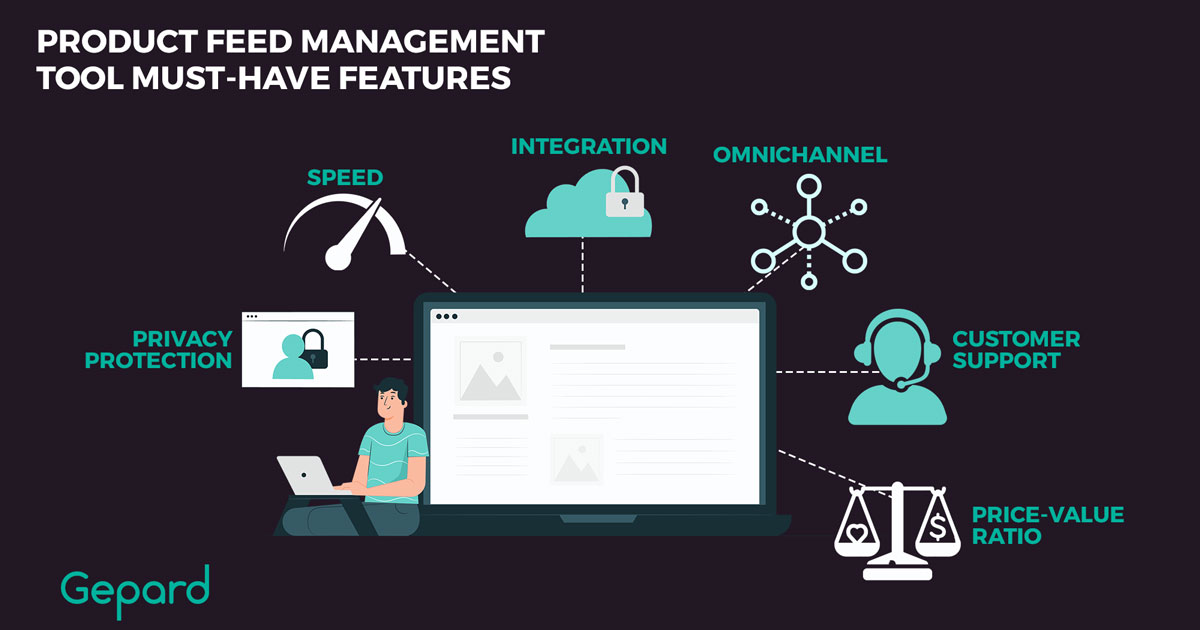What Is Product Feed Management And How It Improves Product Content
If you are searching for a guarantee of retail success, it might be helpful to find out what is product feed management and how to use it for your brand. Read about the practical importance of product feed and find out how to optimize your data processes in the ever-changing eCommerce world.
Well-arranged shopping feed management is the basis of your success in retail. When it’s managed well and regularly updated across eCommerce channels, it becomes a guarantee for your cozy and stable place under the sun and the rays of the buyers’ affection.
What Is Product Feed Management
It is also about having rich data such as quality pictures and videos, in all possible angles, with an ability to rotate, zoom, and see how it would look/feel like for a customer to already have an item. Let’s see the product feed example:
 Got 1000+ Product Items? Leverage Data Feed Management
Got 1000+ Product Items? Leverage Data Feed Management
Answering a possible rising question, who even needs implementing product feed management, a short reply would be — you (as you probably already requested to find this topic). You’re selling goods. Or maybe providing services? And you already passed that phase, when you had a few stuff to sell online left from your garage sale. Now you developed in a 1000+ product items vendor and you might want to push on Amazon, Google Shopping, and so on. And a big business demands big solutions.
Why Using Product Feeds?
- Reach more potential clientele via additional retail channels.
- Send product listings to various sales channels.
- Update product feed on time.
- Adjust product information to different locales.
- Have rich product content transformed into your data model.
..follow the article to find out more.
And let’s have a look at ways to improve a product feed. We will start with the basics and proceed to product feed management on wider scopes.
Key Points to Strike Product Feed Optimization
My advice — start with a title. Then optimize the keywords. Do you know how your customers get to your page? What are their search queries? This is a hint on how to manage your keywords. Think in terms of your customers’ needs. Make sure to put the most important product information at the beginning — this would drive better results. So don’t mess up with Google, or other search engines. Structurize the data smartly. And make Google think your feed and a shopper’s search question are a perfect match. Tip: you’ll find a link to a nice keyword-optimizing tool down in an article.
Product type and product title are the 2 necessary product information pieces to be included in a product feed. No matter what niche your products are. Be aware you have 150 words to reach your favorite shopper. In most cases, only half will be shown. There would be loads of product feed requirements like this. So better educate your team on it and learn How to Write Product Descriptions. Also, here’s a basic product data list Google has, for instance.
It all sounds good and manageable for small businesses. But how will you handle these feeds operating on huge scopes in a fast-paced rhythm? Automate. Be efficient.
Another obstacle will flow up when you’d decide to expand your online market presence and capture various shopping channels. Let’s have a look specifically at this case.
Data Feed Management In An Omnichannel Shopping Environment

Of course, it’s tempting to hold on to the old-school process with excel docs by your side. But let’s do the real thing. If you have 1000+ products, It’s pretty tough to manipulate the shopping feed data already. I bet. Come with me and see for yourself why to have a product content syndicator.
Managing a shopping data feed still, seems a no-brainer.
Shopping engines, as Amazon, Google, eBay, Shopify, etc. are unique and have their own formats and specifications. Your task here would be a timely and exact product feed despatch, update, and other various shopping data manipulations.
Most Popular Shopping Channels
Let me be useful and outline just some crucial marketplace feed management peculiarities on each of them:
Google Shopping.
If you are a reseller – you might benefit from GTIN [Global Trade Item Number]. Google takes it to extract from the supplier’s catalog and places your ad into an auction with the other resellers of the same product. The same works on Amazon. Besides, GTINs can place your product according to the quality and the number of reviews you have if a shopper types “top..” or “best..” in a search engine. Also, as promised, catch a google keyword optimizing tool.
Amazon.
In July 2018 Amazon released an AFS (Amazon Feed Specification). What is it and how it is beneficial for all parties? It’s a data-interchanging standard, enabling all Amazon vendors to manage product content & sales in a single manner. You’ll need to adjust your product data formats to Amazon’s AFS, so first you need to register a CSP, a catalog service provider, you’re working with, to adjust your data with Amazon’s standards. Learn more about the benefits and easy steps on how to do it with a case study.
eBay.
Meet Cassini. A search engine inside eBay. And your task here is to develop a deep and profound relationship with it. Because it determines where and how your product is going to be displayed to the customer. Except for figuring out the best search match based on product data itself, it looks at feedback, shipping costs, and return policies.
Psst, want some product feed management software?
Before jumping to naming and analyzing shopping feed management software, let’s go through the list of the features a tool should have to benefit your business.
10 Must-Have Components Of A Product Feed Management Tool
 Speed. The software should increase your efficiency and be a time saver. Consider this when choosing a feed management platform.
Speed. The software should increase your efficiency and be a time saver. Consider this when choosing a feed management platform.
Simplicity. Right, simplicity to navigate across the app, or a highly qualified support team to set up everything for you. It should be clear and straightforward.
Scope. How many channels does it support? How many countries? How many product groups you’d be able to manage?
Automation. Manual feed input may work for small webshops, while for the ones managing big data feeds, it would instantly cause time and human resource management issues.
Integration. Would this software match your databases etc.? Does it have an API for all necessary integrations? You want to be able to combine data from your PIM and various sales channels, your shop system, etc.
Omnichannel. Does it have templates for all e-marketplaces you want to sell at?
Optimization. Is the tool able to optimize data, like images and other product data? Does it analyze the data to further give recommendations on optimization and improvement?
Privacy protection. No need to explain the importance of information security in this era.
Customer support is mostly a forgotten component, but if something would go wrong or you would simply have some questions, you’d want to refer to customer support asap, not to lose the revenue from sales.
Price-Value ratio. You want to get exactly what you’re paying for. And get a highly flexible and customizable solution. How you’ll be charged? Per click? Or per number of products?
Manage Your Product Feed With Gepard
Now that you know what is product feed management and how it benefits your brand, are you ready to optimize your product data?
Entrust Gepard with this task: this will help you automate the product feed management while your team can stay productive and focus on more creative business tasks and ideas.
Get in touch with our committed professionals for a free consultation to learn how Gepard can help you with your data-related goals.


